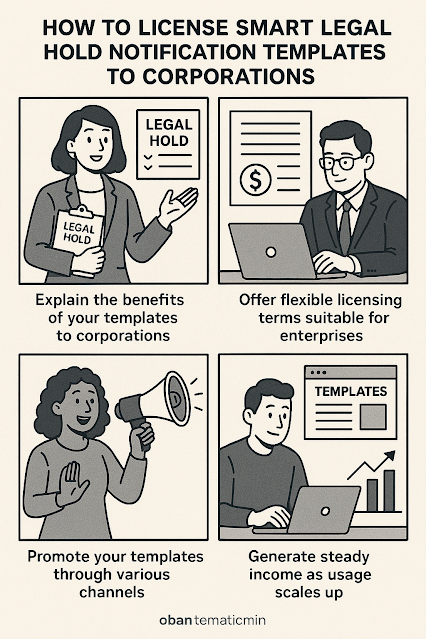How to License Smart Legal Hold Notification Templates to Corporations
In today’s digital-first legal operations environment, corporations face mounting challenges when it comes to managing legal holds and ensuring defensible compliance.
Smart legal hold notification templates—automated, structured, and pre-compliant with major standards like GDPR and HIPAA—can be a powerful B2B product.
In this guide, we’ll break down how to develop, license, and scale your own smart legal hold templates for enterprise clients.
📌 Table of Contents
- Why Corporations Need Smart Legal Hold Templates
- Developing Compliant, Scalable Templates
- Structuring Licensing Agreements
- Marketing and Distribution Channels
- Recommended Platforms to Promote Your Templates
🎯 Why Corporations Need Smart Legal Hold Templates
Legal holds are notices that companies issue to employees to preserve data relevant to potential or ongoing litigation.
Manual processes are error-prone and risky—missing even a single custodian can result in legal exposure.
By contrast, automated templates ensure every step is tracked, repeatable, and compliant with evolving laws.
Corporations are increasingly adopting legal tech tools, creating a lucrative niche for templated automation.
🛠️ Developing Compliant, Scalable Templates
Start by identifying legal hold requirements based on U.S. Federal Rules of Civil Procedure (FRCP), GDPR for EU data, and specific industry guidelines such as HIPAA or FINRA.
Your templates should include:
Dynamic merge fields (e.g., custodian name, case ID, response links)
Conditional instructions based on jurisdiction
Audit-ready logs for delivery and acknowledgment
You can build them using tools like Microsoft Word (with scripts/macros), PDF generators, or integrate directly with litigation support platforms like Logikcull or Zapproved.
📄 Structuring Licensing Agreements
When licensing to corporations, the goal is to offer flexibility while protecting your IP.
Popular licensing models include:
Per-use License: Charged per case or per custodian notice.
Annual Subscription: Unlimited usage with ongoing updates and compliance checks.
White-label Licensing: Corporations brand your templates as internal tools.
Use licensing contracts that clarify:
Scope of use (jurisdiction, team size)
Modification rights (can the template be edited?)
Termination and support clauses
🚀 Marketing and Distribution Channels
To reach legal departments, focus your marketing on legal operations blogs, LinkedIn, and B2B marketplaces.
Some proven strategies include:
Publishing case studies on how your templates reduce legal risk
Offering a free "sample hold letter" in exchange for emails
Partnering with legal tech vendors for integration bundles
🌐 Recommended Platforms to Promote Your Templates
To maximize discoverability and build legal SEO authority, publish educational content and licensing opportunities on specialized blogs.
For example, check out this legal-tech-friendly resource hub:
📎 Visit Doctorinfore for LegalTech Use CasesThis blog regularly covers document automation, legal AI trends, and compliance topics, offering you a relevant audience and backlink potential.
You can also feature your content on:
- Infoparad - for automation and compliance workflows
- Advinform - for legal innovation case studies
- Goinfo001 - business solutions and SaaS templates
📌 Final Thoughts
Licensing smart legal hold notification templates isn’t just a niche legal tech move—it’s a high-leverage strategy for monetizing your compliance expertise.
Focus on building structured, modular, and updatable templates that scale across industries.
With the right licensing structure and content distribution strategy, you can turn a one-time template into a recurring revenue stream.
Important Keywords: legal hold template, legal tech licensing, smart notification compliance, document automation, SaaS for legal

